University Report: Mental Health and Well-being in Education Sector
VerifiedAdded on 2022/11/18
|18
|3428
|428
Report
AI Summary
This report delves into the critical issue of mental health and well-being among employees in the education sector, focusing on the Australian context. It begins by defining mental health according to WHO standards and highlights the increasing prevalence of mental health challenges in the workplace, particularly within the education sector. The report presents statistical data illustrating the impact of mental illness on employee productivity and the financial burden it places on the Australian economy. It explores the need for targeted educational programs to address workplace stressors and psychosocial factors contributing to mental health issues, while also acknowledging barriers to effective implementation. The report proposes the 'Prioritizing Mental Health – National Mental Health Workplace Initiative' as a practical solution, emphasizing its focus on creating rewarding work environments and addressing factors like job-related stress and lack of support. It then analyzes the problems solved by this program, underscoring the importance of a person-first approach in mental health education. The report also discusses the advantages and limitations of the proposed program, emphasizing its practicality within the educational setting and its potential to reduce employee stress and improve overall well-being. The author has focused on adapting the person first approach while planning the implementation plan to address the limitations seen in past mental health education program.
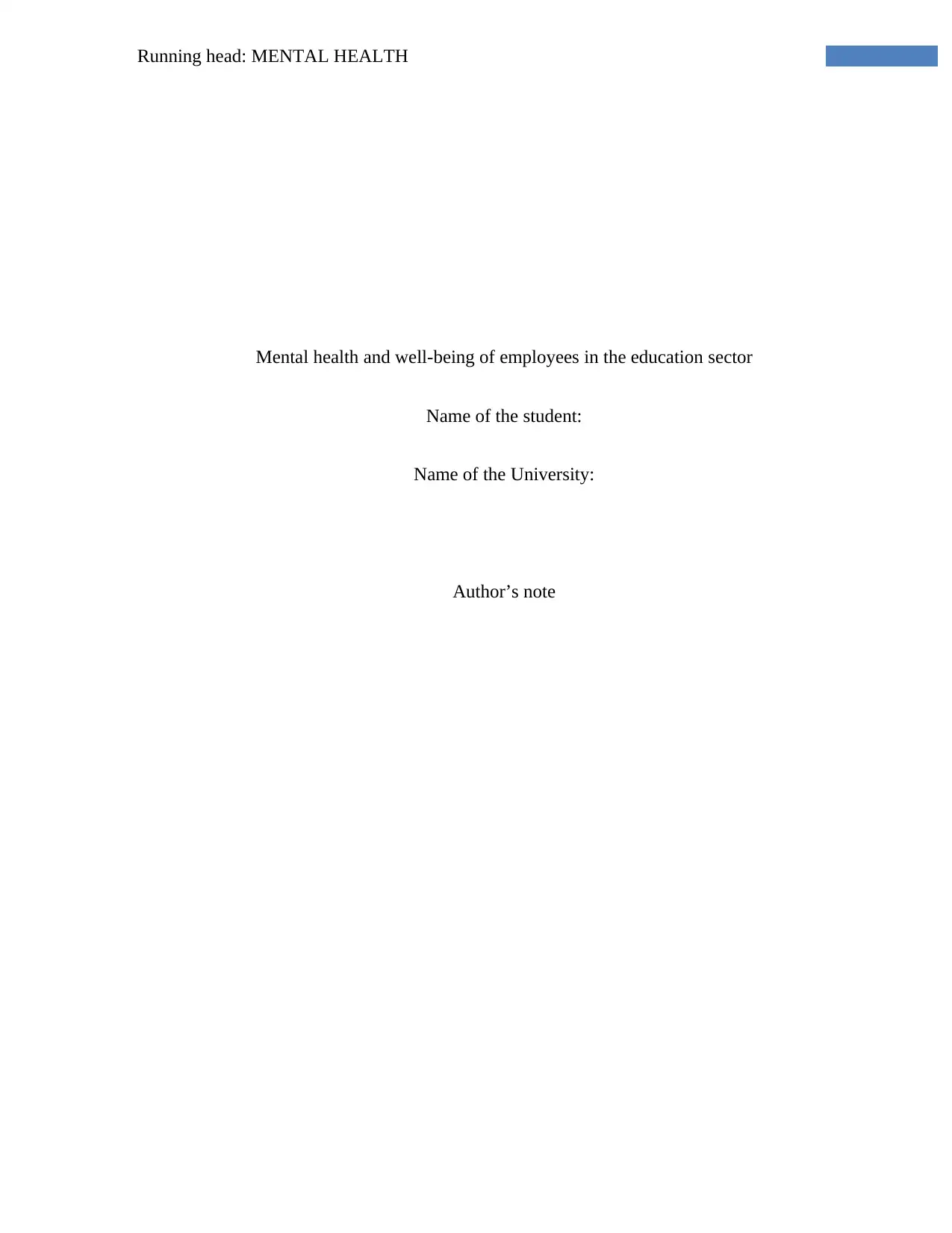
Running head: MENTAL HEALTH
Mental health and well-being of employees in the education sector
Name of the student:
Name of the University:
Author’s note
Mental health and well-being of employees in the education sector
Name of the student:
Name of the University:
Author’s note
Paraphrase This Document
Need a fresh take? Get an instant paraphrase of this document with our AI Paraphraser
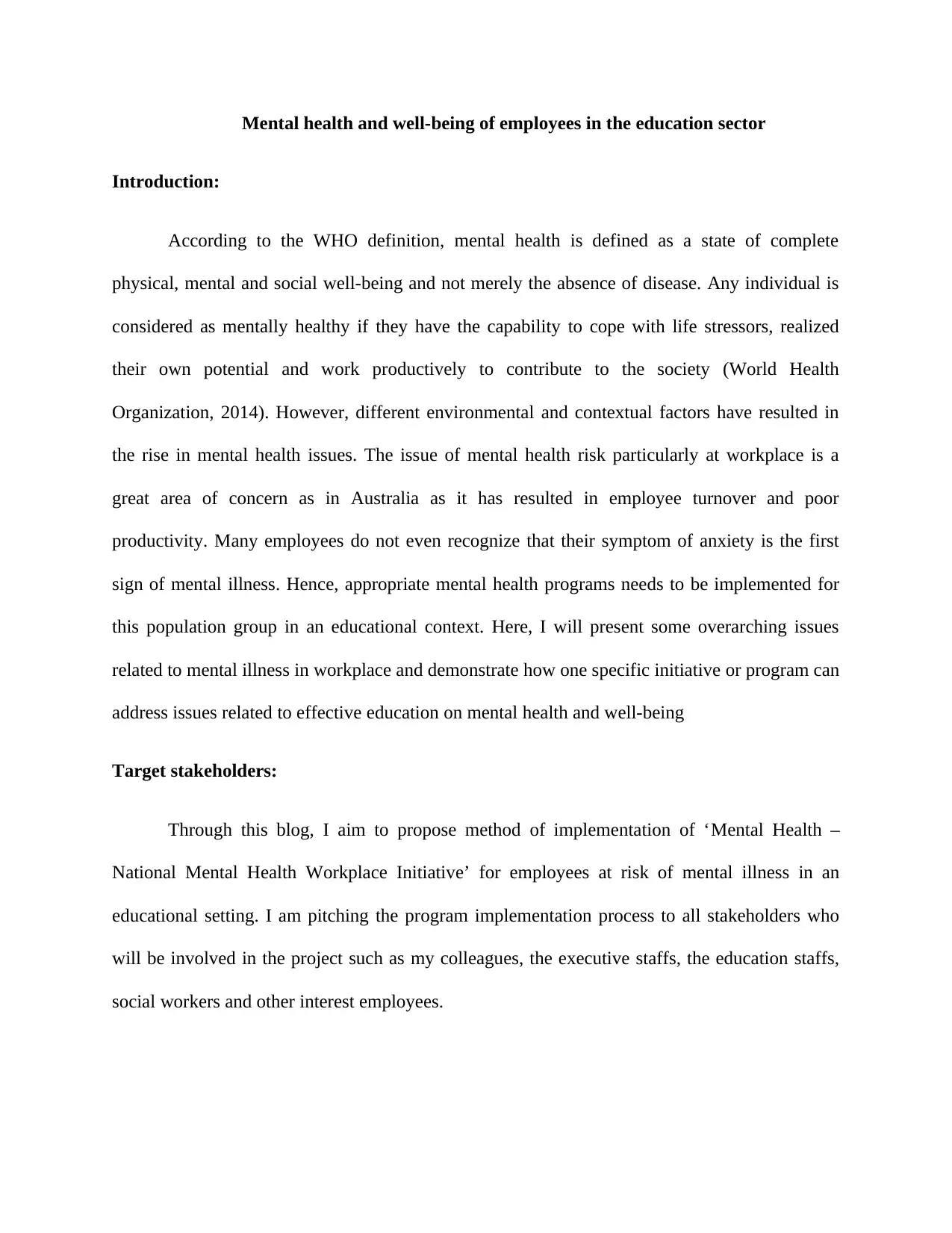
Mental health and well-being of employees in the education sector
Introduction:
According to the WHO definition, mental health is defined as a state of complete
physical, mental and social well-being and not merely the absence of disease. Any individual is
considered as mentally healthy if they have the capability to cope with life stressors, realized
their own potential and work productively to contribute to the society (World Health
Organization, 2014). However, different environmental and contextual factors have resulted in
the rise in mental health issues. The issue of mental health risk particularly at workplace is a
great area of concern as in Australia as it has resulted in employee turnover and poor
productivity. Many employees do not even recognize that their symptom of anxiety is the first
sign of mental illness. Hence, appropriate mental health programs needs to be implemented for
this population group in an educational context. Here, I will present some overarching issues
related to mental illness in workplace and demonstrate how one specific initiative or program can
address issues related to effective education on mental health and well-being
Target stakeholders:
Through this blog, I aim to propose method of implementation of ‘Mental Health –
National Mental Health Workplace Initiative’ for employees at risk of mental illness in an
educational setting. I am pitching the program implementation process to all stakeholders who
will be involved in the project such as my colleagues, the executive staffs, the education staffs,
social workers and other interest employees.
Introduction:
According to the WHO definition, mental health is defined as a state of complete
physical, mental and social well-being and not merely the absence of disease. Any individual is
considered as mentally healthy if they have the capability to cope with life stressors, realized
their own potential and work productively to contribute to the society (World Health
Organization, 2014). However, different environmental and contextual factors have resulted in
the rise in mental health issues. The issue of mental health risk particularly at workplace is a
great area of concern as in Australia as it has resulted in employee turnover and poor
productivity. Many employees do not even recognize that their symptom of anxiety is the first
sign of mental illness. Hence, appropriate mental health programs needs to be implemented for
this population group in an educational context. Here, I will present some overarching issues
related to mental illness in workplace and demonstrate how one specific initiative or program can
address issues related to effective education on mental health and well-being
Target stakeholders:
Through this blog, I aim to propose method of implementation of ‘Mental Health –
National Mental Health Workplace Initiative’ for employees at risk of mental illness in an
educational setting. I am pitching the program implementation process to all stakeholders who
will be involved in the project such as my colleagues, the executive staffs, the education staffs,
social workers and other interest employees.
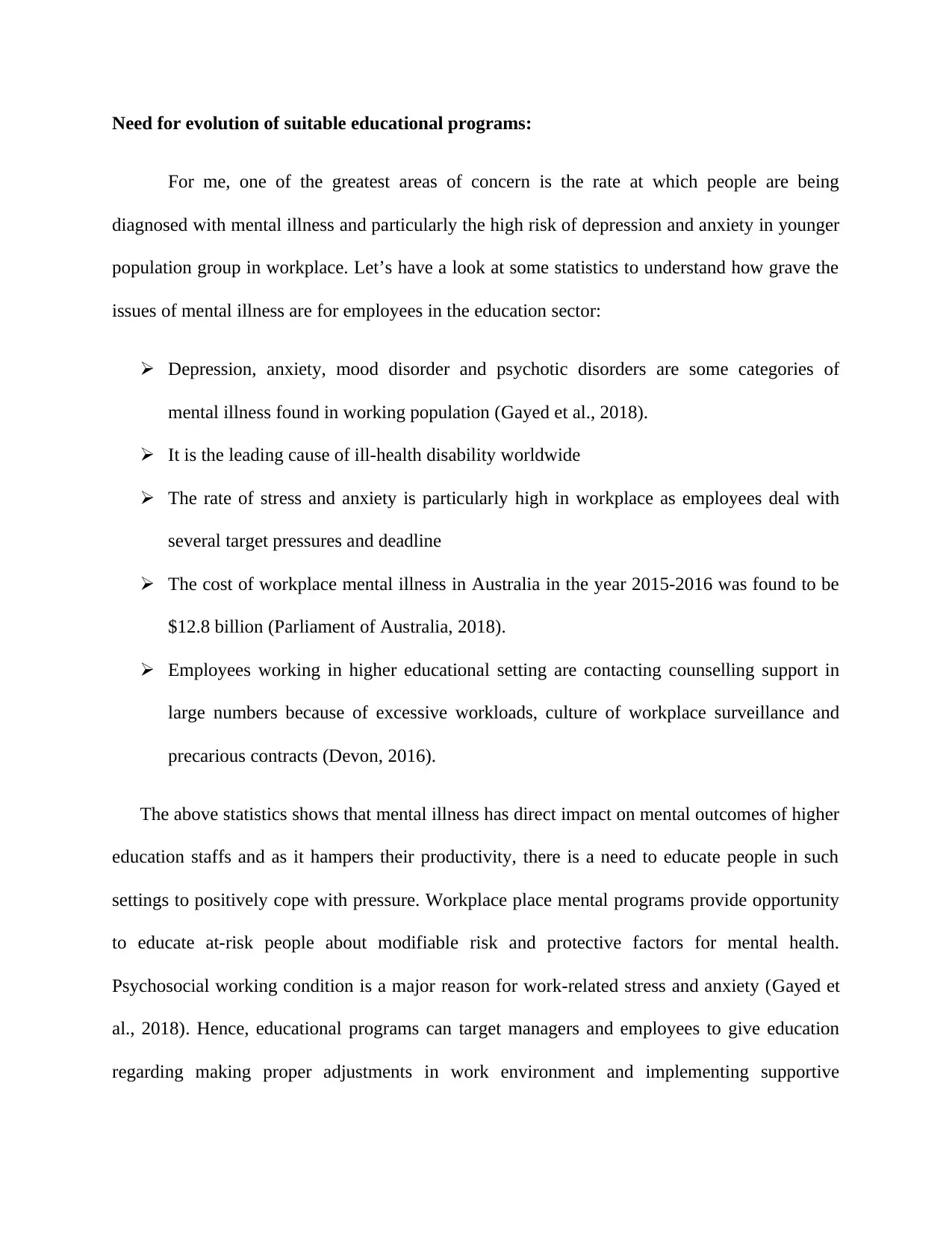
Need for evolution of suitable educational programs:
For me, one of the greatest areas of concern is the rate at which people are being
diagnosed with mental illness and particularly the high risk of depression and anxiety in younger
population group in workplace. Let’s have a look at some statistics to understand how grave the
issues of mental illness are for employees in the education sector:
Depression, anxiety, mood disorder and psychotic disorders are some categories of
mental illness found in working population (Gayed et al., 2018).
It is the leading cause of ill-health disability worldwide
The rate of stress and anxiety is particularly high in workplace as employees deal with
several target pressures and deadline
The cost of workplace mental illness in Australia in the year 2015-2016 was found to be
$12.8 billion (Parliament of Australia, 2018).
Employees working in higher educational setting are contacting counselling support in
large numbers because of excessive workloads, culture of workplace surveillance and
precarious contracts (Devon, 2016).
The above statistics shows that mental illness has direct impact on mental outcomes of higher
education staffs and as it hampers their productivity, there is a need to educate people in such
settings to positively cope with pressure. Workplace place mental programs provide opportunity
to educate at-risk people about modifiable risk and protective factors for mental health.
Psychosocial working condition is a major reason for work-related stress and anxiety (Gayed et
al., 2018). Hence, educational programs can target managers and employees to give education
regarding making proper adjustments in work environment and implementing supportive
For me, one of the greatest areas of concern is the rate at which people are being
diagnosed with mental illness and particularly the high risk of depression and anxiety in younger
population group in workplace. Let’s have a look at some statistics to understand how grave the
issues of mental illness are for employees in the education sector:
Depression, anxiety, mood disorder and psychotic disorders are some categories of
mental illness found in working population (Gayed et al., 2018).
It is the leading cause of ill-health disability worldwide
The rate of stress and anxiety is particularly high in workplace as employees deal with
several target pressures and deadline
The cost of workplace mental illness in Australia in the year 2015-2016 was found to be
$12.8 billion (Parliament of Australia, 2018).
Employees working in higher educational setting are contacting counselling support in
large numbers because of excessive workloads, culture of workplace surveillance and
precarious contracts (Devon, 2016).
The above statistics shows that mental illness has direct impact on mental outcomes of higher
education staffs and as it hampers their productivity, there is a need to educate people in such
settings to positively cope with pressure. Workplace place mental programs provide opportunity
to educate at-risk people about modifiable risk and protective factors for mental health.
Psychosocial working condition is a major reason for work-related stress and anxiety (Gayed et
al., 2018). Hence, educational programs can target managers and employees to give education
regarding making proper adjustments in work environment and implementing supportive
⊘ This is a preview!⊘
Do you want full access?
Subscribe today to unlock all pages.

Trusted by 1+ million students worldwide
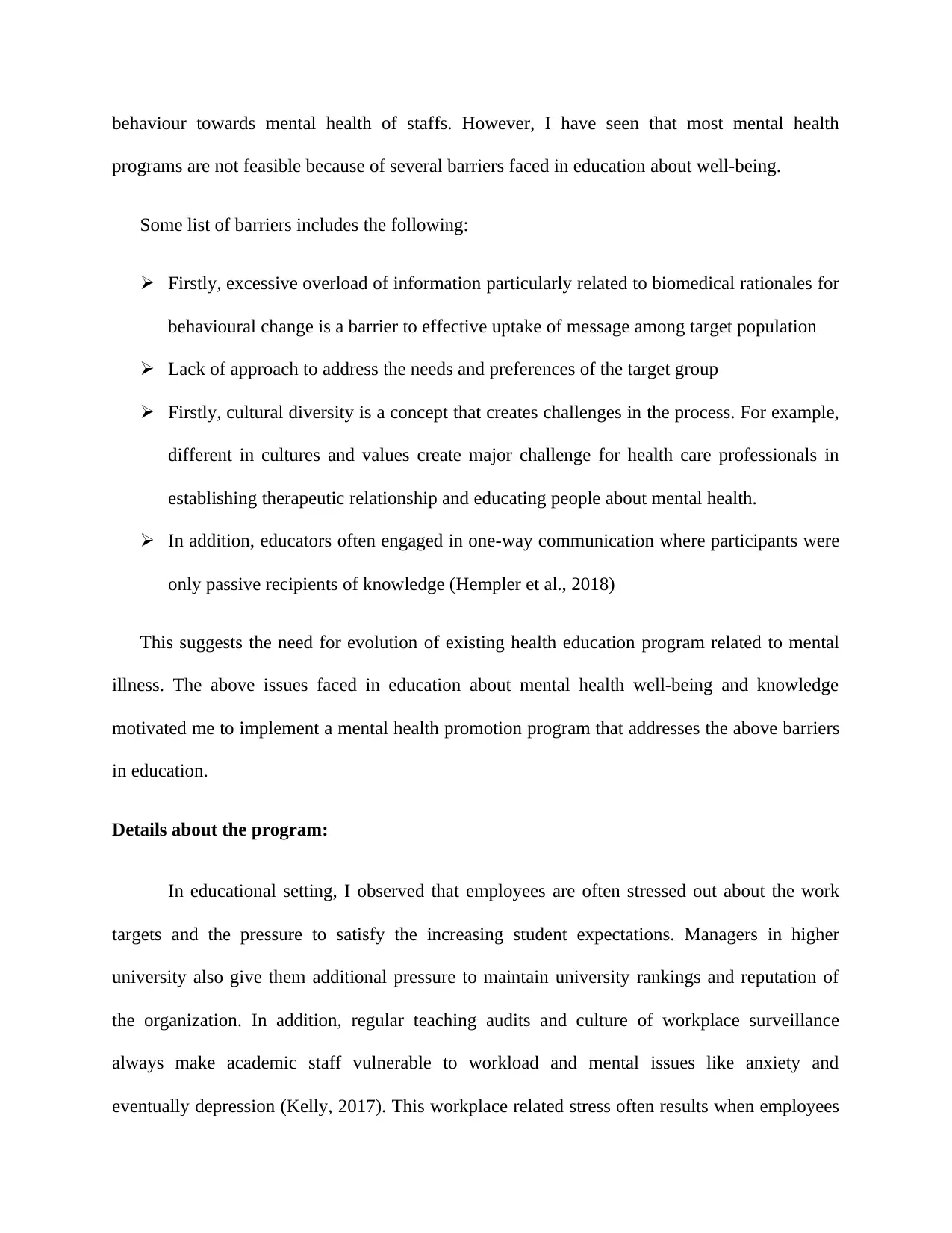
behaviour towards mental health of staffs. However, I have seen that most mental health
programs are not feasible because of several barriers faced in education about well-being.
Some list of barriers includes the following:
Firstly, excessive overload of information particularly related to biomedical rationales for
behavioural change is a barrier to effective uptake of message among target population
Lack of approach to address the needs and preferences of the target group
Firstly, cultural diversity is a concept that creates challenges in the process. For example,
different in cultures and values create major challenge for health care professionals in
establishing therapeutic relationship and educating people about mental health.
In addition, educators often engaged in one-way communication where participants were
only passive recipients of knowledge (Hempler et al., 2018)
This suggests the need for evolution of existing health education program related to mental
illness. The above issues faced in education about mental health well-being and knowledge
motivated me to implement a mental health promotion program that addresses the above barriers
in education.
Details about the program:
In educational setting, I observed that employees are often stressed out about the work
targets and the pressure to satisfy the increasing student expectations. Managers in higher
university also give them additional pressure to maintain university rankings and reputation of
the organization. In addition, regular teaching audits and culture of workplace surveillance
always make academic staff vulnerable to workload and mental issues like anxiety and
eventually depression (Kelly, 2017). This workplace related stress often results when employees
programs are not feasible because of several barriers faced in education about well-being.
Some list of barriers includes the following:
Firstly, excessive overload of information particularly related to biomedical rationales for
behavioural change is a barrier to effective uptake of message among target population
Lack of approach to address the needs and preferences of the target group
Firstly, cultural diversity is a concept that creates challenges in the process. For example,
different in cultures and values create major challenge for health care professionals in
establishing therapeutic relationship and educating people about mental health.
In addition, educators often engaged in one-way communication where participants were
only passive recipients of knowledge (Hempler et al., 2018)
This suggests the need for evolution of existing health education program related to mental
illness. The above issues faced in education about mental health well-being and knowledge
motivated me to implement a mental health promotion program that addresses the above barriers
in education.
Details about the program:
In educational setting, I observed that employees are often stressed out about the work
targets and the pressure to satisfy the increasing student expectations. Managers in higher
university also give them additional pressure to maintain university rankings and reputation of
the organization. In addition, regular teaching audits and culture of workplace surveillance
always make academic staff vulnerable to workload and mental issues like anxiety and
eventually depression (Kelly, 2017). This workplace related stress often results when employees
Paraphrase This Document
Need a fresh take? Get an instant paraphrase of this document with our AI Paraphraser
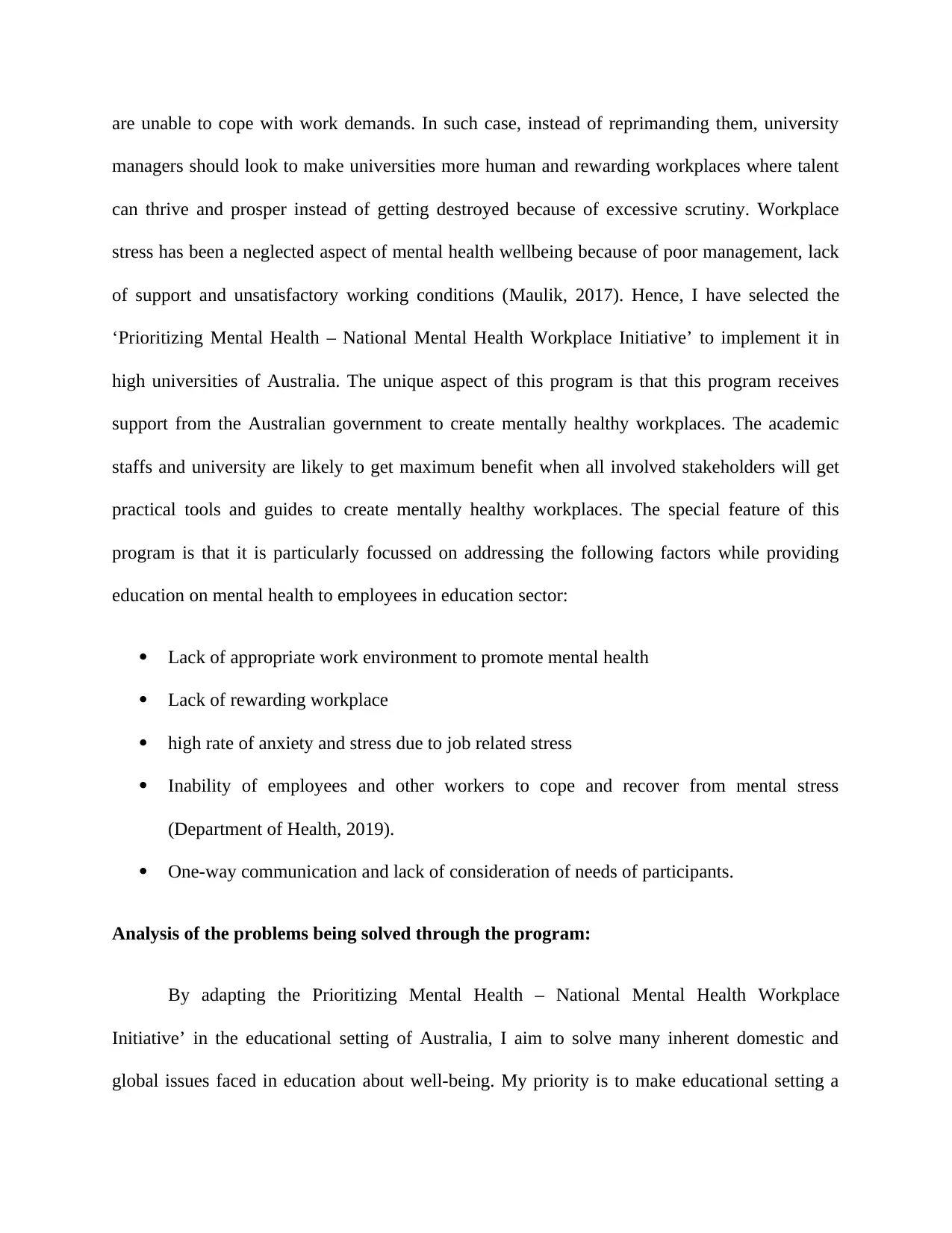
are unable to cope with work demands. In such case, instead of reprimanding them, university
managers should look to make universities more human and rewarding workplaces where talent
can thrive and prosper instead of getting destroyed because of excessive scrutiny. Workplace
stress has been a neglected aspect of mental health wellbeing because of poor management, lack
of support and unsatisfactory working conditions (Maulik, 2017). Hence, I have selected the
‘Prioritizing Mental Health – National Mental Health Workplace Initiative’ to implement it in
high universities of Australia. The unique aspect of this program is that this program receives
support from the Australian government to create mentally healthy workplaces. The academic
staffs and university are likely to get maximum benefit when all involved stakeholders will get
practical tools and guides to create mentally healthy workplaces. The special feature of this
program is that it is particularly focussed on addressing the following factors while providing
education on mental health to employees in education sector:
Lack of appropriate work environment to promote mental health
Lack of rewarding workplace
high rate of anxiety and stress due to job related stress
Inability of employees and other workers to cope and recover from mental stress
(Department of Health, 2019).
One-way communication and lack of consideration of needs of participants.
Analysis of the problems being solved through the program:
By adapting the Prioritizing Mental Health – National Mental Health Workplace
Initiative’ in the educational setting of Australia, I aim to solve many inherent domestic and
global issues faced in education about well-being. My priority is to make educational setting a
managers should look to make universities more human and rewarding workplaces where talent
can thrive and prosper instead of getting destroyed because of excessive scrutiny. Workplace
stress has been a neglected aspect of mental health wellbeing because of poor management, lack
of support and unsatisfactory working conditions (Maulik, 2017). Hence, I have selected the
‘Prioritizing Mental Health – National Mental Health Workplace Initiative’ to implement it in
high universities of Australia. The unique aspect of this program is that this program receives
support from the Australian government to create mentally healthy workplaces. The academic
staffs and university are likely to get maximum benefit when all involved stakeholders will get
practical tools and guides to create mentally healthy workplaces. The special feature of this
program is that it is particularly focussed on addressing the following factors while providing
education on mental health to employees in education sector:
Lack of appropriate work environment to promote mental health
Lack of rewarding workplace
high rate of anxiety and stress due to job related stress
Inability of employees and other workers to cope and recover from mental stress
(Department of Health, 2019).
One-way communication and lack of consideration of needs of participants.
Analysis of the problems being solved through the program:
By adapting the Prioritizing Mental Health – National Mental Health Workplace
Initiative’ in the educational setting of Australia, I aim to solve many inherent domestic and
global issues faced in education about well-being. My priority is to make educational setting a
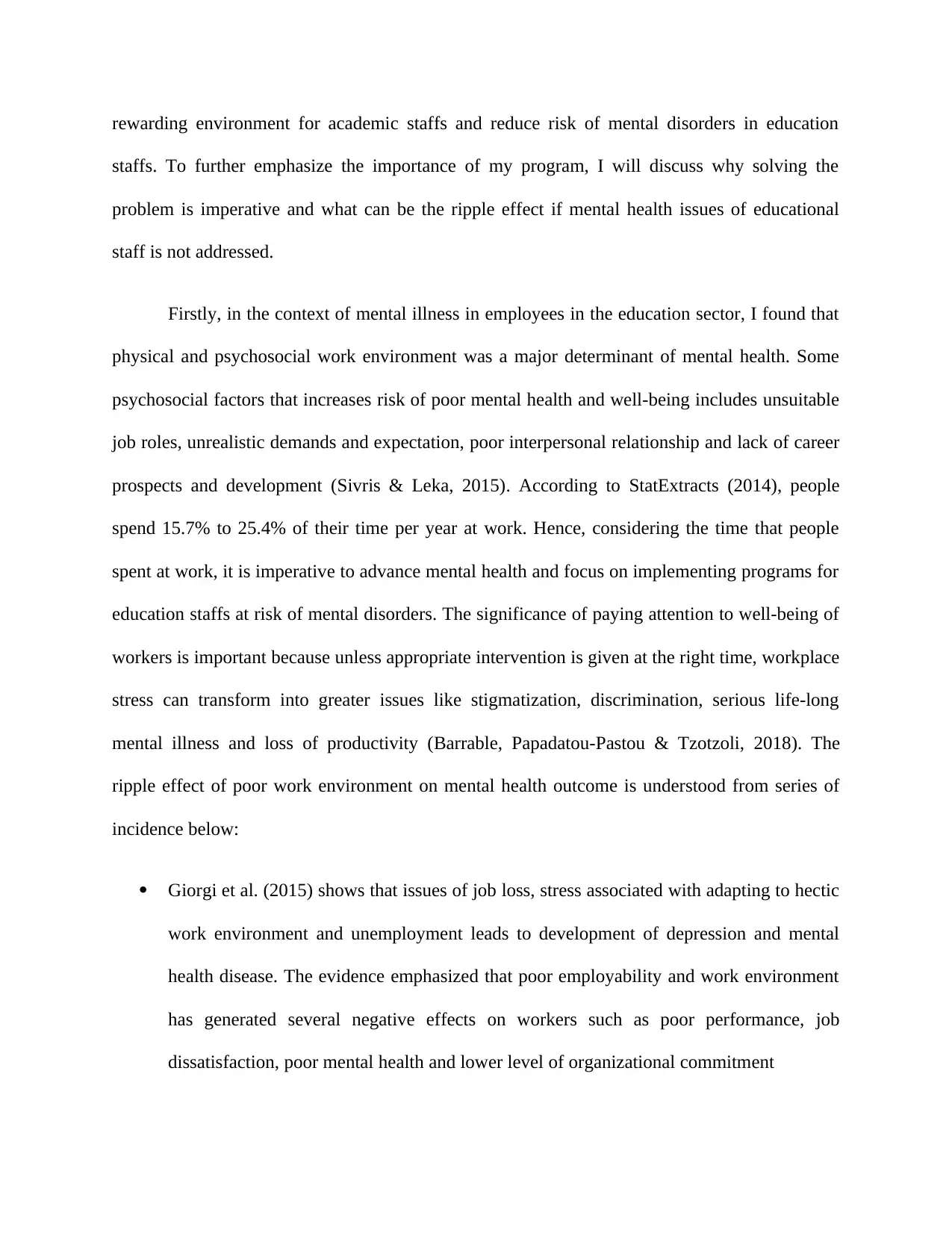
rewarding environment for academic staffs and reduce risk of mental disorders in education
staffs. To further emphasize the importance of my program, I will discuss why solving the
problem is imperative and what can be the ripple effect if mental health issues of educational
staff is not addressed.
Firstly, in the context of mental illness in employees in the education sector, I found that
physical and psychosocial work environment was a major determinant of mental health. Some
psychosocial factors that increases risk of poor mental health and well-being includes unsuitable
job roles, unrealistic demands and expectation, poor interpersonal relationship and lack of career
prospects and development (Sivris & Leka, 2015). According to StatExtracts (2014), people
spend 15.7% to 25.4% of their time per year at work. Hence, considering the time that people
spent at work, it is imperative to advance mental health and focus on implementing programs for
education staffs at risk of mental disorders. The significance of paying attention to well-being of
workers is important because unless appropriate intervention is given at the right time, workplace
stress can transform into greater issues like stigmatization, discrimination, serious life-long
mental illness and loss of productivity (Barrable, Papadatou-Pastou & Tzotzoli, 2018). The
ripple effect of poor work environment on mental health outcome is understood from series of
incidence below:
Giorgi et al. (2015) shows that issues of job loss, stress associated with adapting to hectic
work environment and unemployment leads to development of depression and mental
health disease. The evidence emphasized that poor employability and work environment
has generated several negative effects on workers such as poor performance, job
dissatisfaction, poor mental health and lower level of organizational commitment
staffs. To further emphasize the importance of my program, I will discuss why solving the
problem is imperative and what can be the ripple effect if mental health issues of educational
staff is not addressed.
Firstly, in the context of mental illness in employees in the education sector, I found that
physical and psychosocial work environment was a major determinant of mental health. Some
psychosocial factors that increases risk of poor mental health and well-being includes unsuitable
job roles, unrealistic demands and expectation, poor interpersonal relationship and lack of career
prospects and development (Sivris & Leka, 2015). According to StatExtracts (2014), people
spend 15.7% to 25.4% of their time per year at work. Hence, considering the time that people
spent at work, it is imperative to advance mental health and focus on implementing programs for
education staffs at risk of mental disorders. The significance of paying attention to well-being of
workers is important because unless appropriate intervention is given at the right time, workplace
stress can transform into greater issues like stigmatization, discrimination, serious life-long
mental illness and loss of productivity (Barrable, Papadatou-Pastou & Tzotzoli, 2018). The
ripple effect of poor work environment on mental health outcome is understood from series of
incidence below:
Giorgi et al. (2015) shows that issues of job loss, stress associated with adapting to hectic
work environment and unemployment leads to development of depression and mental
health disease. The evidence emphasized that poor employability and work environment
has generated several negative effects on workers such as poor performance, job
dissatisfaction, poor mental health and lower level of organizational commitment
⊘ This is a preview!⊘
Do you want full access?
Subscribe today to unlock all pages.

Trusted by 1+ million students worldwide
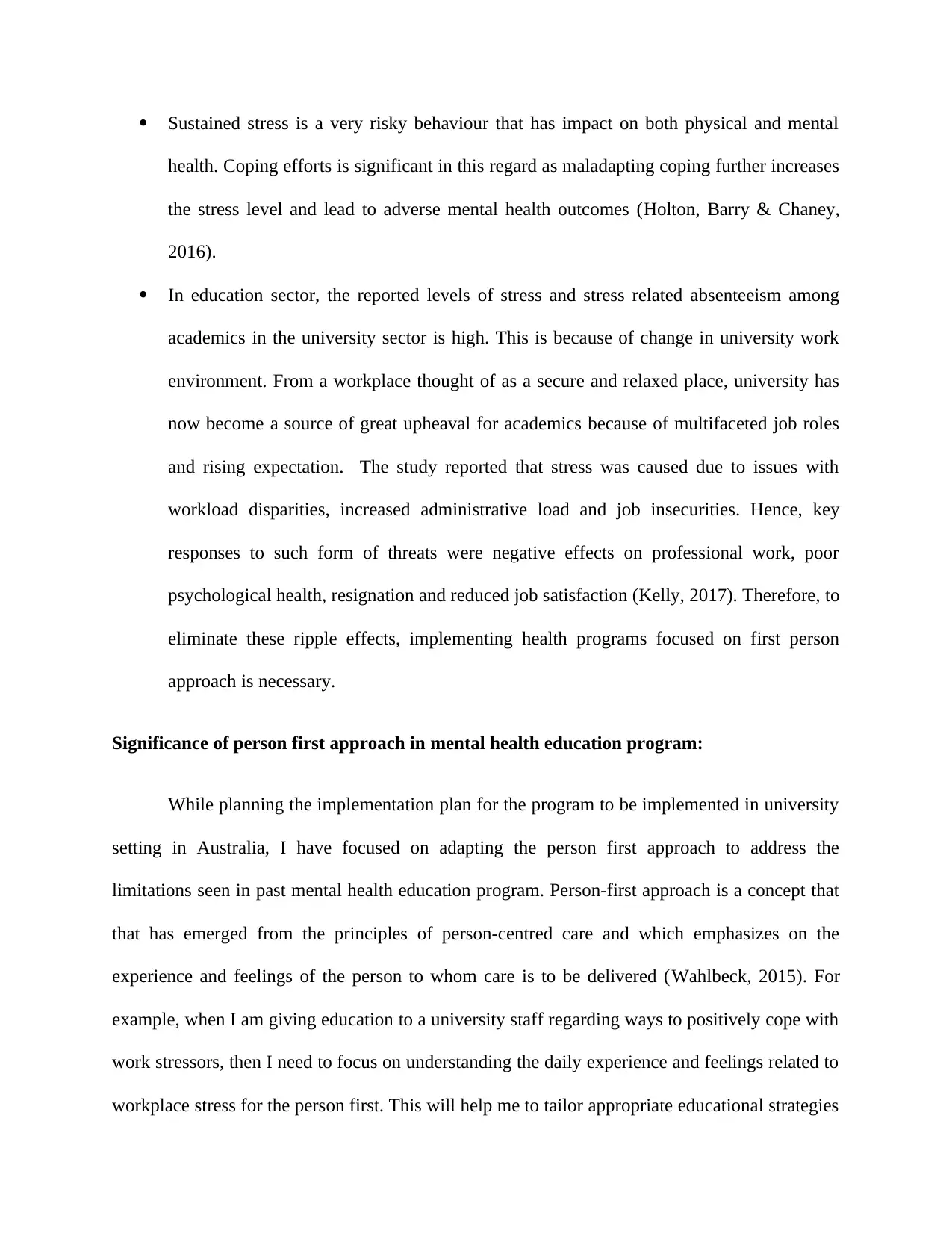
Sustained stress is a very risky behaviour that has impact on both physical and mental
health. Coping efforts is significant in this regard as maladapting coping further increases
the stress level and lead to adverse mental health outcomes (Holton, Barry & Chaney,
2016).
In education sector, the reported levels of stress and stress related absenteeism among
academics in the university sector is high. This is because of change in university work
environment. From a workplace thought of as a secure and relaxed place, university has
now become a source of great upheaval for academics because of multifaceted job roles
and rising expectation. The study reported that stress was caused due to issues with
workload disparities, increased administrative load and job insecurities. Hence, key
responses to such form of threats were negative effects on professional work, poor
psychological health, resignation and reduced job satisfaction (Kelly, 2017). Therefore, to
eliminate these ripple effects, implementing health programs focused on first person
approach is necessary.
Significance of person first approach in mental health education program:
While planning the implementation plan for the program to be implemented in university
setting in Australia, I have focused on adapting the person first approach to address the
limitations seen in past mental health education program. Person-first approach is a concept that
that has emerged from the principles of person-centred care and which emphasizes on the
experience and feelings of the person to whom care is to be delivered (Wahlbeck, 2015). For
example, when I am giving education to a university staff regarding ways to positively cope with
work stressors, then I need to focus on understanding the daily experience and feelings related to
workplace stress for the person first. This will help me to tailor appropriate educational strategies
health. Coping efforts is significant in this regard as maladapting coping further increases
the stress level and lead to adverse mental health outcomes (Holton, Barry & Chaney,
2016).
In education sector, the reported levels of stress and stress related absenteeism among
academics in the university sector is high. This is because of change in university work
environment. From a workplace thought of as a secure and relaxed place, university has
now become a source of great upheaval for academics because of multifaceted job roles
and rising expectation. The study reported that stress was caused due to issues with
workload disparities, increased administrative load and job insecurities. Hence, key
responses to such form of threats were negative effects on professional work, poor
psychological health, resignation and reduced job satisfaction (Kelly, 2017). Therefore, to
eliminate these ripple effects, implementing health programs focused on first person
approach is necessary.
Significance of person first approach in mental health education program:
While planning the implementation plan for the program to be implemented in university
setting in Australia, I have focused on adapting the person first approach to address the
limitations seen in past mental health education program. Person-first approach is a concept that
that has emerged from the principles of person-centred care and which emphasizes on the
experience and feelings of the person to whom care is to be delivered (Wahlbeck, 2015). For
example, when I am giving education to a university staff regarding ways to positively cope with
work stressors, then I need to focus on understanding the daily experience and feelings related to
workplace stress for the person first. This will help me to tailor appropriate educational strategies
Paraphrase This Document
Need a fresh take? Get an instant paraphrase of this document with our AI Paraphraser
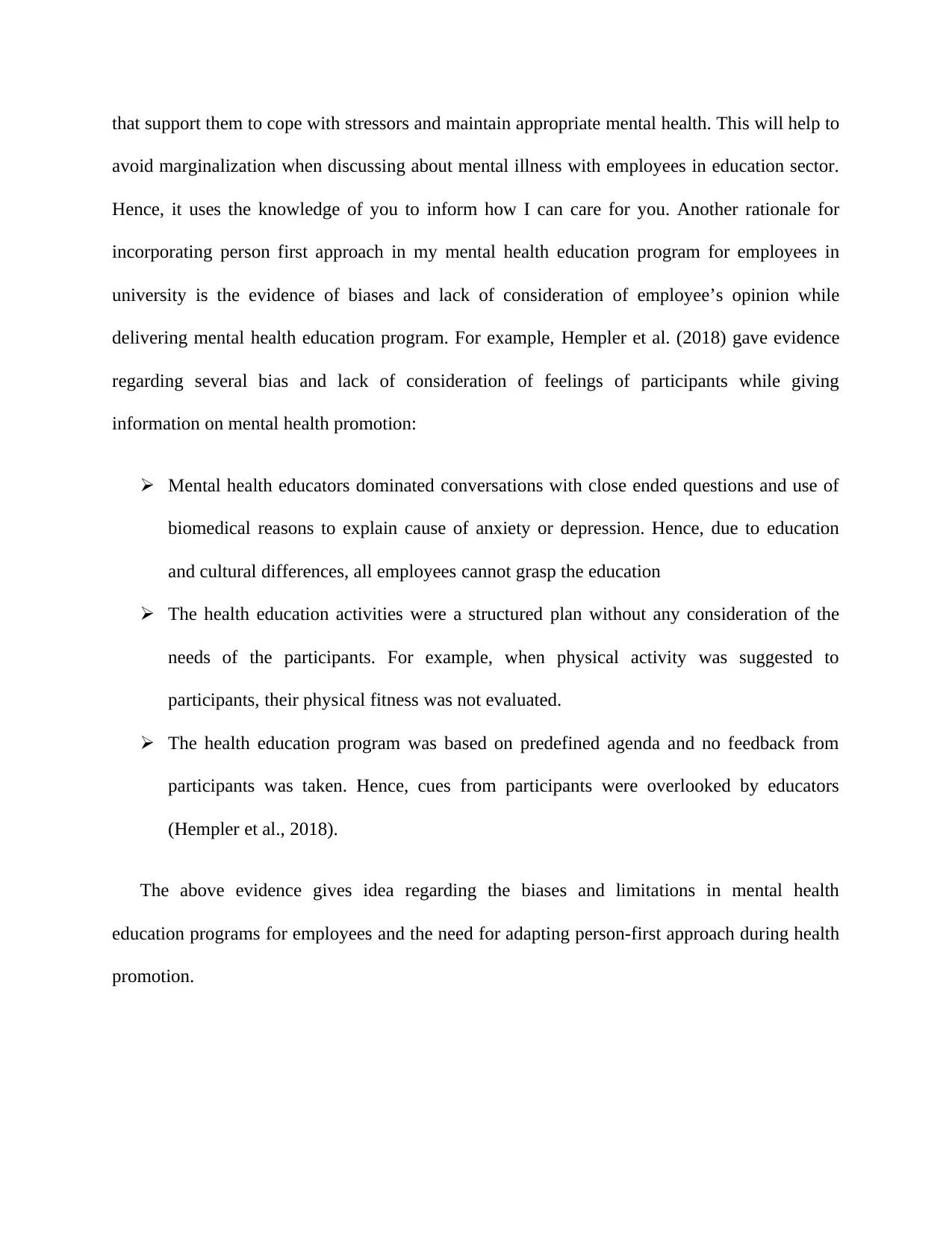
that support them to cope with stressors and maintain appropriate mental health. This will help to
avoid marginalization when discussing about mental illness with employees in education sector.
Hence, it uses the knowledge of you to inform how I can care for you. Another rationale for
incorporating person first approach in my mental health education program for employees in
university is the evidence of biases and lack of consideration of employee’s opinion while
delivering mental health education program. For example, Hempler et al. (2018) gave evidence
regarding several bias and lack of consideration of feelings of participants while giving
information on mental health promotion:
Mental health educators dominated conversations with close ended questions and use of
biomedical reasons to explain cause of anxiety or depression. Hence, due to education
and cultural differences, all employees cannot grasp the education
The health education activities were a structured plan without any consideration of the
needs of the participants. For example, when physical activity was suggested to
participants, their physical fitness was not evaluated.
The health education program was based on predefined agenda and no feedback from
participants was taken. Hence, cues from participants were overlooked by educators
(Hempler et al., 2018).
The above evidence gives idea regarding the biases and limitations in mental health
education programs for employees and the need for adapting person-first approach during health
promotion.
avoid marginalization when discussing about mental illness with employees in education sector.
Hence, it uses the knowledge of you to inform how I can care for you. Another rationale for
incorporating person first approach in my mental health education program for employees in
university is the evidence of biases and lack of consideration of employee’s opinion while
delivering mental health education program. For example, Hempler et al. (2018) gave evidence
regarding several bias and lack of consideration of feelings of participants while giving
information on mental health promotion:
Mental health educators dominated conversations with close ended questions and use of
biomedical reasons to explain cause of anxiety or depression. Hence, due to education
and cultural differences, all employees cannot grasp the education
The health education activities were a structured plan without any consideration of the
needs of the participants. For example, when physical activity was suggested to
participants, their physical fitness was not evaluated.
The health education program was based on predefined agenda and no feedback from
participants was taken. Hence, cues from participants were overlooked by educators
(Hempler et al., 2018).
The above evidence gives idea regarding the biases and limitations in mental health
education programs for employees and the need for adapting person-first approach during health
promotion.
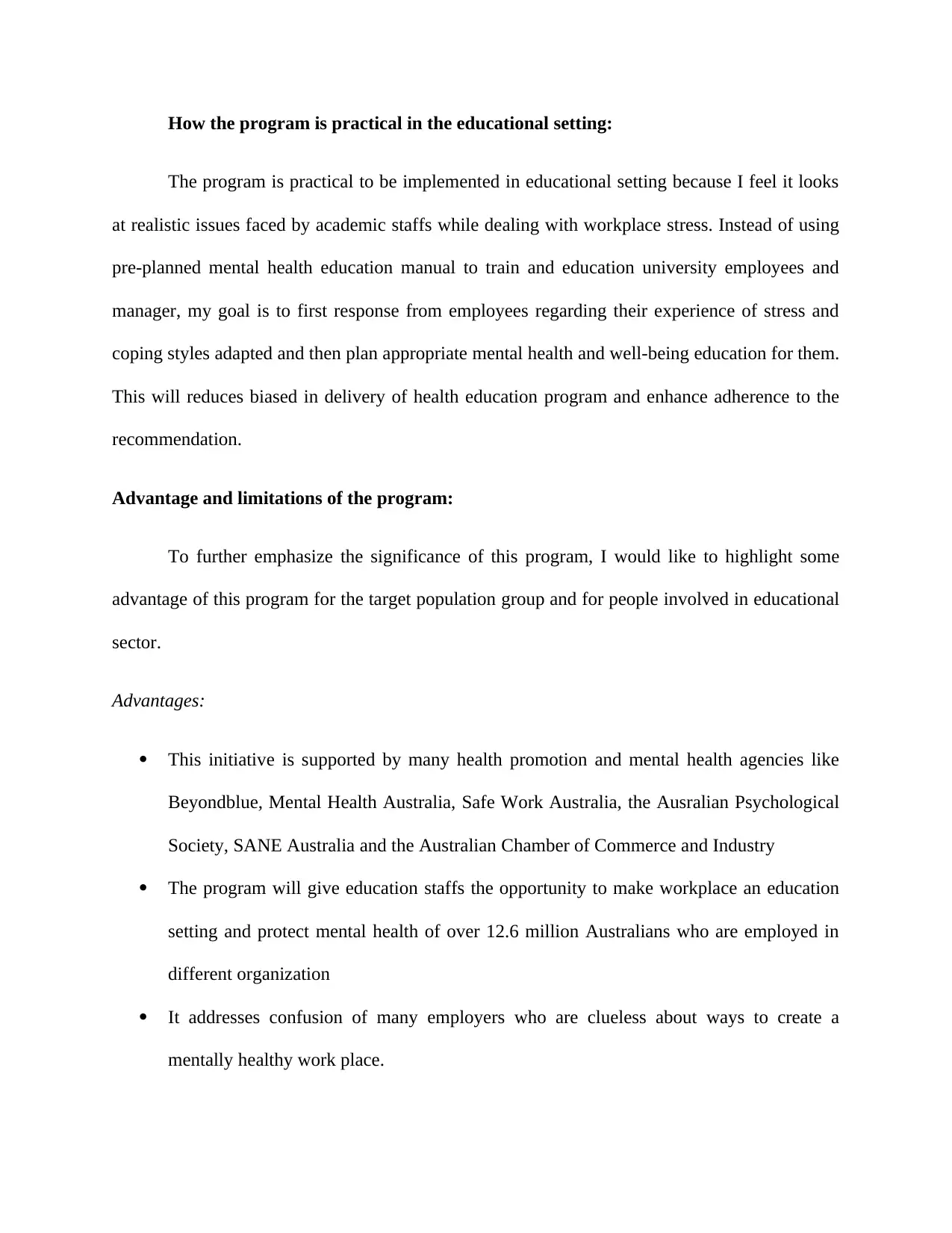
How the program is practical in the educational setting:
The program is practical to be implemented in educational setting because I feel it looks
at realistic issues faced by academic staffs while dealing with workplace stress. Instead of using
pre-planned mental health education manual to train and education university employees and
manager, my goal is to first response from employees regarding their experience of stress and
coping styles adapted and then plan appropriate mental health and well-being education for them.
This will reduces biased in delivery of health education program and enhance adherence to the
recommendation.
Advantage and limitations of the program:
To further emphasize the significance of this program, I would like to highlight some
advantage of this program for the target population group and for people involved in educational
sector.
Advantages:
This initiative is supported by many health promotion and mental health agencies like
Beyondblue, Mental Health Australia, Safe Work Australia, the Ausralian Psychological
Society, SANE Australia and the Australian Chamber of Commerce and Industry
The program will give education staffs the opportunity to make workplace an education
setting and protect mental health of over 12.6 million Australians who are employed in
different organization
It addresses confusion of many employers who are clueless about ways to create a
mentally healthy work place.
The program is practical to be implemented in educational setting because I feel it looks
at realistic issues faced by academic staffs while dealing with workplace stress. Instead of using
pre-planned mental health education manual to train and education university employees and
manager, my goal is to first response from employees regarding their experience of stress and
coping styles adapted and then plan appropriate mental health and well-being education for them.
This will reduces biased in delivery of health education program and enhance adherence to the
recommendation.
Advantage and limitations of the program:
To further emphasize the significance of this program, I would like to highlight some
advantage of this program for the target population group and for people involved in educational
sector.
Advantages:
This initiative is supported by many health promotion and mental health agencies like
Beyondblue, Mental Health Australia, Safe Work Australia, the Ausralian Psychological
Society, SANE Australia and the Australian Chamber of Commerce and Industry
The program will give education staffs the opportunity to make workplace an education
setting and protect mental health of over 12.6 million Australians who are employed in
different organization
It addresses confusion of many employers who are clueless about ways to create a
mentally healthy work place.
⊘ This is a preview!⊘
Do you want full access?
Subscribe today to unlock all pages.

Trusted by 1+ million students worldwide
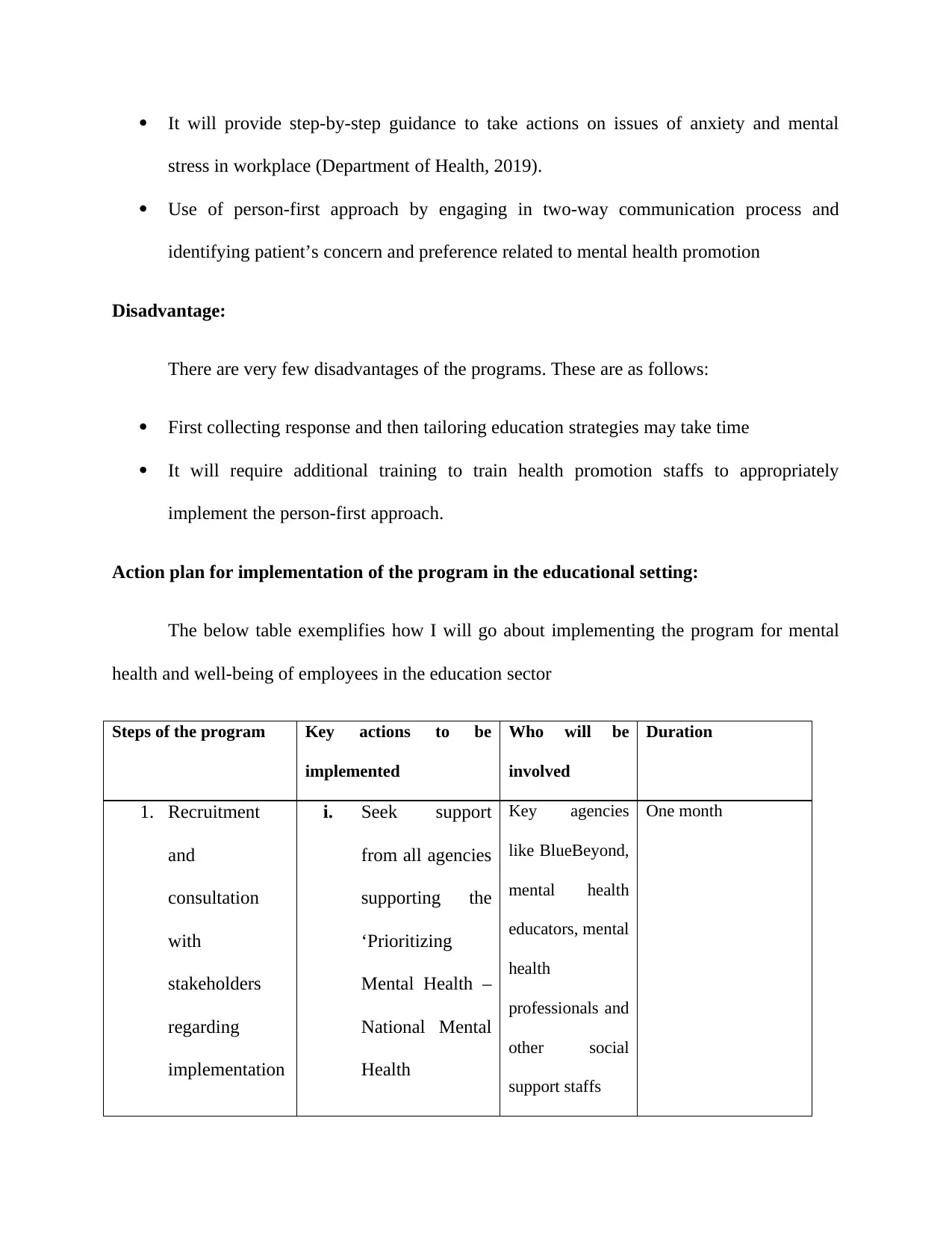
It will provide step-by-step guidance to take actions on issues of anxiety and mental
stress in workplace (Department of Health, 2019).
Use of person-first approach by engaging in two-way communication process and
identifying patient’s concern and preference related to mental health promotion
Disadvantage:
There are very few disadvantages of the programs. These are as follows:
First collecting response and then tailoring education strategies may take time
It will require additional training to train health promotion staffs to appropriately
implement the person-first approach.
Action plan for implementation of the program in the educational setting:
The below table exemplifies how I will go about implementing the program for mental
health and well-being of employees in the education sector
Steps of the program Key actions to be
implemented
Who will be
involved
Duration
1. Recruitment
and
consultation
with
stakeholders
regarding
implementation
i. Seek support
from all agencies
supporting the
‘Prioritizing
Mental Health –
National Mental
Health
Key agencies
like BlueBeyond,
mental health
educators, mental
health
professionals and
other social
support staffs
One month
stress in workplace (Department of Health, 2019).
Use of person-first approach by engaging in two-way communication process and
identifying patient’s concern and preference related to mental health promotion
Disadvantage:
There are very few disadvantages of the programs. These are as follows:
First collecting response and then tailoring education strategies may take time
It will require additional training to train health promotion staffs to appropriately
implement the person-first approach.
Action plan for implementation of the program in the educational setting:
The below table exemplifies how I will go about implementing the program for mental
health and well-being of employees in the education sector
Steps of the program Key actions to be
implemented
Who will be
involved
Duration
1. Recruitment
and
consultation
with
stakeholders
regarding
implementation
i. Seek support
from all agencies
supporting the
‘Prioritizing
Mental Health –
National Mental
Health
Key agencies
like BlueBeyond,
mental health
educators, mental
health
professionals and
other social
support staffs
One month
Paraphrase This Document
Need a fresh take? Get an instant paraphrase of this document with our AI Paraphraser
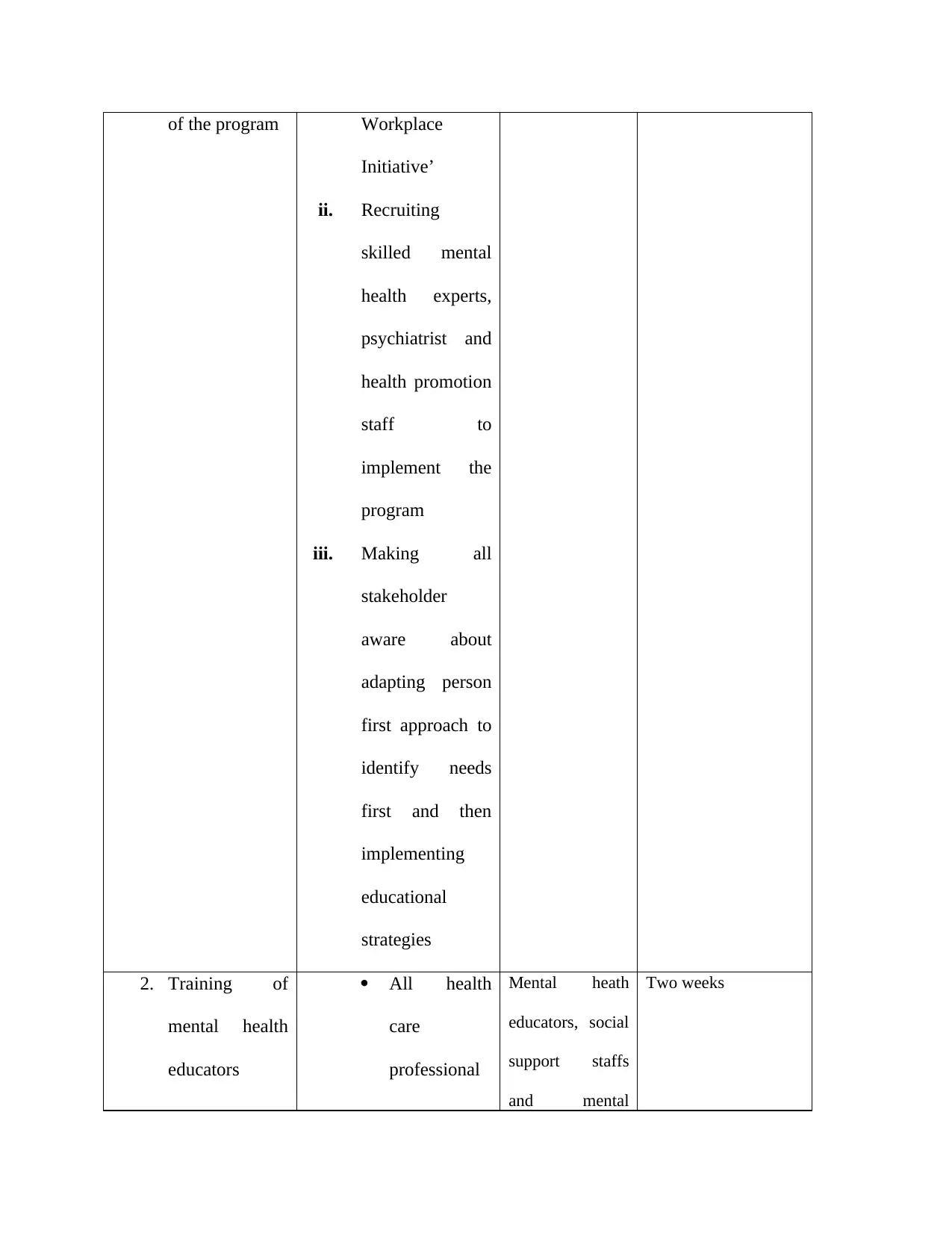
of the program Workplace
Initiative’
ii. Recruiting
skilled mental
health experts,
psychiatrist and
health promotion
staff to
implement the
program
iii. Making all
stakeholder
aware about
adapting person
first approach to
identify needs
first and then
implementing
educational
strategies
2. Training of
mental health
educators
All health
care
professional
Mental heath
educators, social
support staffs
and mental
Two weeks
Initiative’
ii. Recruiting
skilled mental
health experts,
psychiatrist and
health promotion
staff to
implement the
program
iii. Making all
stakeholder
aware about
adapting person
first approach to
identify needs
first and then
implementing
educational
strategies
2. Training of
mental health
educators
All health
care
professional
Mental heath
educators, social
support staffs
and mental
Two weeks
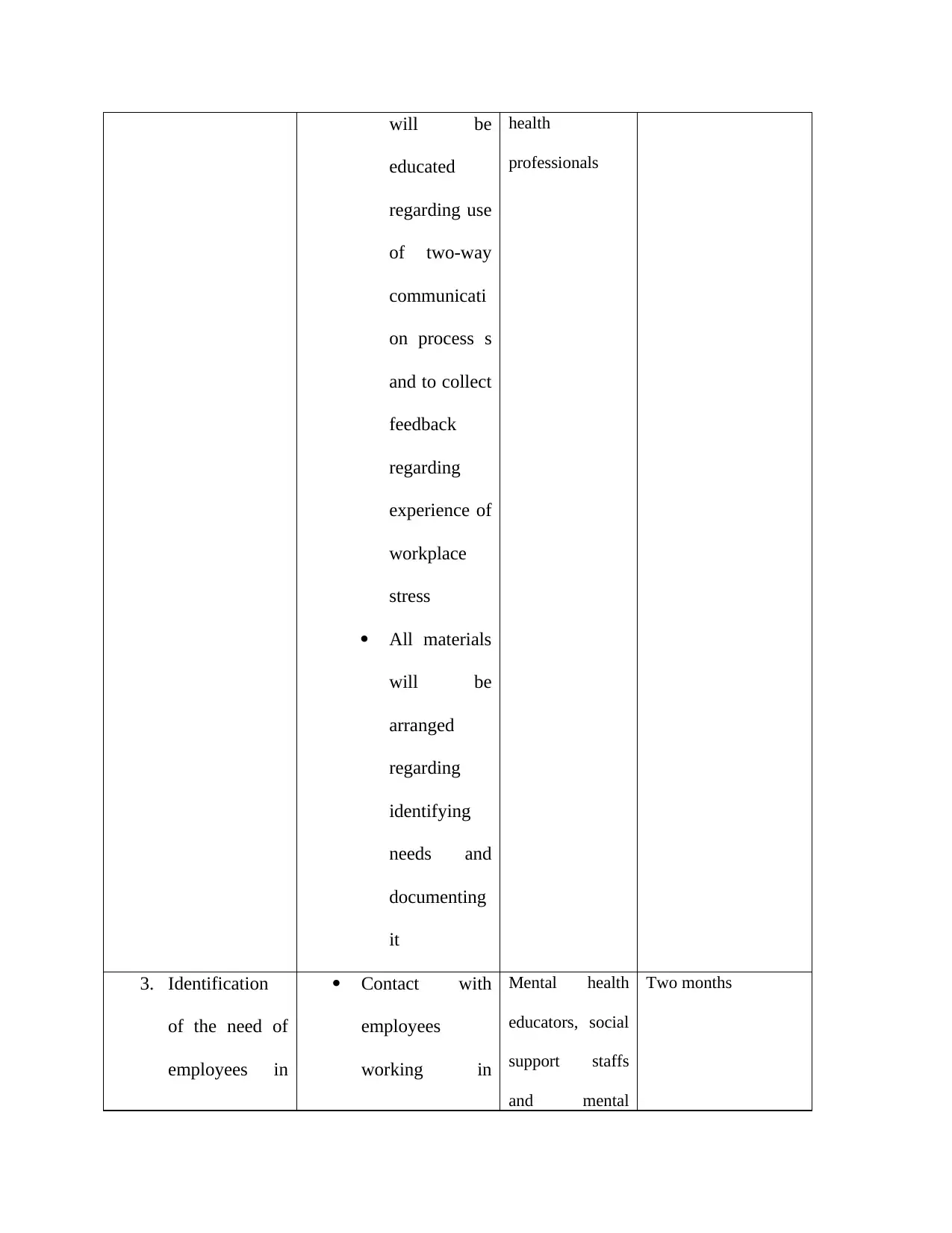
will be
educated
regarding use
of two-way
communicati
on process s
and to collect
feedback
regarding
experience of
workplace
stress
All materials
will be
arranged
regarding
identifying
needs and
documenting
it
health
professionals
3. Identification
of the need of
employees in
Contact with
employees
working in
Mental health
educators, social
support staffs
and mental
Two months
educated
regarding use
of two-way
communicati
on process s
and to collect
feedback
regarding
experience of
workplace
stress
All materials
will be
arranged
regarding
identifying
needs and
documenting
it
health
professionals
3. Identification
of the need of
employees in
Contact with
employees
working in
Mental health
educators, social
support staffs
and mental
Two months
⊘ This is a preview!⊘
Do you want full access?
Subscribe today to unlock all pages.

Trusted by 1+ million students worldwide
1 out of 18
Related Documents
Your All-in-One AI-Powered Toolkit for Academic Success.
+13062052269
info@desklib.com
Available 24*7 on WhatsApp / Email
![[object Object]](/_next/static/media/star-bottom.7253800d.svg)
Unlock your academic potential
Copyright © 2020–2025 A2Z Services. All Rights Reserved. Developed and managed by ZUCOL.





